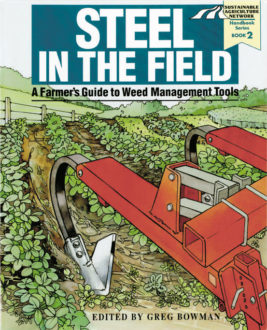Cultivation in Context: Renewed tools for better farming
Facing the Questions
Sure, steel and flame tools can kill weeds. But can they become the foundation of a weed management strategy that works profitably across a range of conditions?
Inevitably, those new to mechanical weed control will ask some of these questions:
- Is it economically efficient?
- Is it as effective as herbicides?
- Is it dependable?
- Is it unwise, because of soil erosion, moisture loss or increased compaction?
The answers must be considered in light of each farmer’s “big picture” approach to crop and soil management. No single tool will provide season-long, year-in/year-out success. But the same is true for herbicides. An appropriate selection of weed management implements can succeed as part of an integrated system with two fundamental requirements: weed competition is suppressed and rows are straight.
Managing overall weed pressure includes making this year’s crop more competitive against weeds and preventing weed seeds or reproductive tissue from building up in the soil. “Cultural management” steps of crop production include crop rotation, the timing of planting, the soil’s biological health and soil physical quality, cover crops (varied rooting depth and soil environment), variety selection, and crop spacing to outcompete weeds.
Some growers achieve uniformly parallel rows with a traditional row-marker disk on an outrigger arm on their planter, while others turn to some type of guidance system. Consistent row alignment allows close-to-the-row settings and high speed. Straight rows and guidance systems change the whole economic picture of mechanical weed control—and how the driver feels by evening. They greatly increase how many acres per day your cultivator can cover, without increasing labor or cultivator costs. Close cultivation decreases how wide the herbicide band needs to be, and allows crop canopy to shade out weeds sooner in the season. Speed makes it easier to throw weed-smothering soil into the rows during late-season passes.
So, how about MWC—with straight rows and a handle on weed pressure—compared with current herbicide-only systems?
Is MWC economically efficient?
In the Corn Belt, annual herbicide costs (material, application and labor) in 1996 were in the area of $20 to $25 per acre for corn and $25 to $30 per acre for soybeans. An all-mechanical, no-herbicide approach might take two rotary hoeings (at about $2 each) and two cultivations (at about $4 each for a 6R30 unit—one covering six rows, 30 inches apart). That’s $12 per acre, figured at $9.25 per hour for labor.
That total jumps to $22 per acre in dryland, contoured grain sorghum. Further, the “opportunity cost” of labor in critical times varies greatly.
Cost per acre also varies by scale. Agronomists at the University of Wisconsin estimated in 1990 that it cost $3.30 per acre for a farmer to rotary hoe once if the farmer had 100 acres of row crops, but only $1.65 if the farmer had 500 acres.
In mechanical and chemical systems, efficiency varies with weather, planting, crop conditions and the skill of the farmer. An emergency mechanical or herbicide “rescue treatment” can be significant. The unplanned trip will be efficient if it costs less than the yield loss that weeds would have caused.
A mixed approach holds the most promise for the most growers. Banding herbicides places the chemical in a limited-width strip over the row, usually 10 to 15 inches wide. A single herbicide application, banded preemergence, followed by a single late-season cultivation, can manage weeds as effectively as broadcast herbicide-only and with less than half the material, for less money and with reduced herbicide exposure to humans and the environment.
That’s the assertion of Mark Hanna, an Iowa State University agricultural and biosystems engineer who led a four-year study. He says the mix would save an average of $9 per acre for Iowa corn growers, and should apply to wide-row soybeans as well. (“No-till study offers new incentive to cultivate,” Leopold Letter, Vol. 8, No. 4, Winter 1996, Leopold Center for Sustainable Agriculture.)
In fields with moderate to heavy weed pressure with 10-inch herbicide bands, watch weed pressure closely. An earlier, additional cultivation may be needed to keep the crop competitive.
Dairy operators face excruciating labor demands at first cultivation because of haying. Ways to stretch out the cultivation window include staggered plantings of corn and soybeans to prevent large blocks from being ready at once, and diversifying into small grain or vegetable crops to further spread out the work load.
